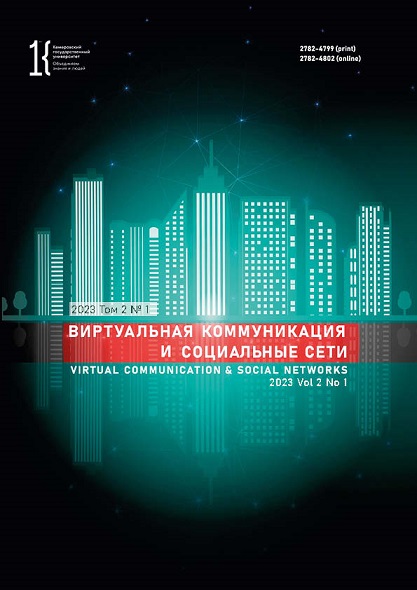Kemerovo, Russian Federation
from 01.01.2007 until now
Kemerovo, Russian Federation
The article introduces attraction marketing methods employed by Russian monthly popular science magazine Diletant. The authors compared the printed version and the website. The paper magazine attracts the reader mainly by the topic name printed on its cover as a unique creolized text. The further semantics of the front media text includes various aspects of the main topic. Color highlights both topical issue and regular features. The comparative analysis with the online version revealed some significant differences. The website has a muted color scheme and minimal animation; it contains neither video nor audio materials. Like in the printed version, the function of attraction belongs mainly to illustrations and subtitles. Online Diletant is interactive in navigation, tests, and surveys, which are, however, the only form of interactivity: the site does not provide comments, forums, “likes”, etc. Such limited use of attention-seeking tools makes the digital version of Diletant uncompetitive and inferior to its paper issue.
Internet communications, cover, media text, hypertext, creolization, polycode text, creolized text, visual design
1. Anisimova E. E. Linguistics of the text and intercultural communication in creolized texts. Moscow: Academia, 2003, 122. (In Russ.) https://www.elibrary.ru/ywotpl
2. Buryakovskaya V. A. Glossy magazine as a phenomenon of mass culture: speech and pragmatic conception. Political Linguistics, 2012, (1): 169–172. (In Russ.) https://elibrary.ru/owuzzd
3. Ermolaeva E. N., Potapova N. V. Lingvovisual pragmatics of pulled-out elements in English-language internet media texts. Vestnik NSU. Series: History and Philology, 2021, 20(6): 247–262. (In Russ.) https://doi.org/10.25205/1818-7919-2021-20-6-247-262 EDN: https://elibrary.ru/RJPLOQ
4. Zvereva E. A. De-aestheticization as a trend of illustration magazine publications. Znak: problemnoe pole mediaobrazovanija, 2018, (2): 23–31. (In Russ.) https://elibrary.ru/xoxuap
5. Zvereva E. A., Biryukova V. V. Influence of the globalization processes on the functioning of glossy magazines. Kultura v fokuse nauchnykh paradigm, 2018, (7): 160–165. (In Russ.) https://elibrary.ru/xzaobn
6. Issers O. S. Discursive practices of our time. Moscow: Lenand, 2021, 272. (In Russ.)
7. Kardapoltseva V. N., Salmin L. Yu. Transformation in the design of visual communications and their consequences. Theory and practice of world science, 2018, (5): 52–55. (In Russ.) https://elibrary.ru/yavlox
8. Kravchenko A. A. Signs of tabloidism on the cover of a popular science magazine: Diletant. Media in the Modern World. 60th St. Petersburg Readings: Proc. 60th Intern. Sci. Forum. St. Petersburg, 30 Jun – 2 Jun 2021. St. Petersburg: Mediapapir, 2021, 109–111. (In Russ.) https://elibrary.ru/twfyho
9. Kruglova L. A. Russian print media: specificity of online versions. Mediascope, 2016, (4). (In Russ.) URL: http://www.mediascope.ru/2205 (accessed 2 Feb 2024). https://elibrary.ru/yhcxdz
10. Mygal M. S., Karpenko I. I. Journalistic hypertext in the system of the mass media internet communications. Nauchnye vedomosti Belgorodskogo gosudarstvennogo universiteta. Seriya: Gumanitarnye nauki, 2011, (18): 201–208. (In Russ.) https://elibrary.ru/qalhih
11. Povarnitsyna M. V. Creolized text specifics in mass Internet communications. Universum: filologiya i iskusstvovedenie, 2015, (6). (In Russ.) https://elibrary.ru/twtvej
12. Polyakova E. V. Structural features of the print and online versions of the newspaper "Republic of Bashkortostan". Vestnik Bashkirskogo universiteta, 2022, 27(1): 197–200. (In Russ.) https://doi.org/10.33184/bulletin-bsu-2022.1.35 EDN: https://elibrary.ru/DQJKHJ
13. Proskurin E. G. Website as polisemiotic hypertext: Problem formulation. The world of science, culture and education, 2010, (3): 64–67. (In Russ.) https://elibrary.ru/mvgupf
14. Sonin A. G. Experimental studies of multimodal text comprehension: Main directions. Voprosy Jazykoznanija, 2005, (6): 115–123. (In Russ.) https://elibrary.ru/hsiroz
15. Sorokin Yu. A., Tarasov E. F. Creolized texts and their communicative function. Optimization of speech communication, ed. Kotov R. G. Moscow: Nauka, 1990, 180–186. (In Russ.)
16. Titlova A. S., Moiseeva A. V. Persuasive potential of a polycoded mass media text. Vestnik Bashkirskogo universiteta, 2019, 24(4): 959–962. (In Russ.) https://doi.org/10.33184/bulletin-bsu-2019.4.32 EDN: https://elibrary.ru/RDAYJH
17. Tszou Kh. Theoretical aspects of studying polycode text in modern linguistics. Philology. Theory & Practice, 2020, 13(1): 295–298. (In Russ.) https://doi.org/10.30853/filnauki.2020.1.58 EDN: https://elibrary.ru/BSBTEA
18. Shevchenko V. E. Theoretical bases of visual communication. Nauchnye vedomosti Belgorodskogo gosudarstvennogo universiteta. Seriya: Gumanitarnye nauki, 2013, (20): 174–180. (In Russ.) https://elibrary.ru/schmrx
19. Czachur W., Opiłowski R., Smykała M. Multimodal practices of empathy and fear in Polish refugee discourse: analysis of magazine covers. GEMA Online Journal of Language Studies, 2022, 22(3): 63–85. https://doi.org/10.17576/gema-2022-2203-04 EDN: https://elibrary.ru/RDWMAA
20. Liu H., Phothisane S., Kotchapakdee P. Changes in visual rhetorical features of new weekly magazine covers published from 1996 to 2001. Southern Semiotic Review, 2022, (16): 91–119. DOI: https://doi.org/10.33234/ssr.16.6; EDN: https://elibrary.ru/HYNKYE
21. Tseronis A. From visual rhetoric to multimodal argumentation: exploring the rhetorical and argumentative relevance of multimodal figures on the covers of The Economist. Visual Communication, 2021, 20(3): 374–396. http://dx.doi.org/10.1177/14703572211005498
















